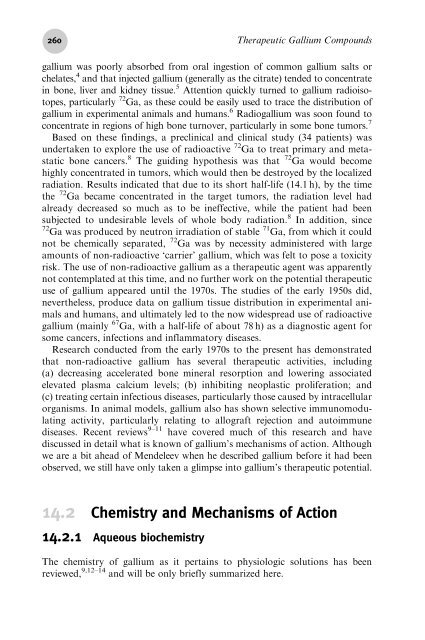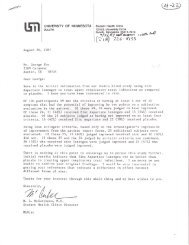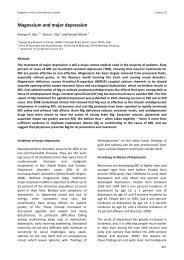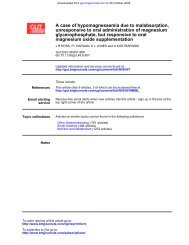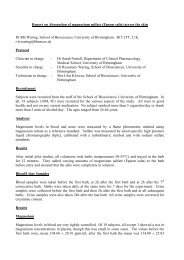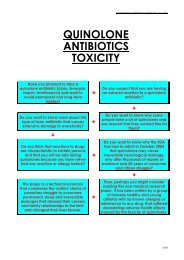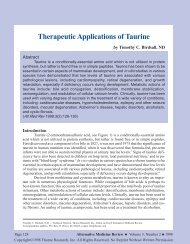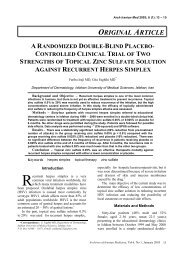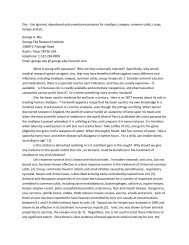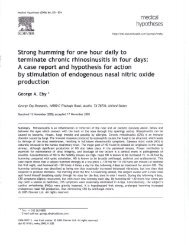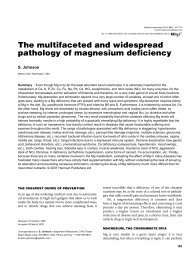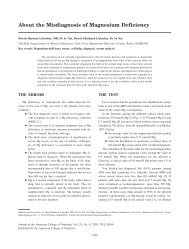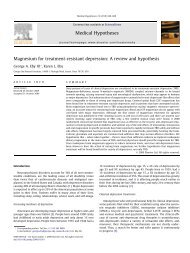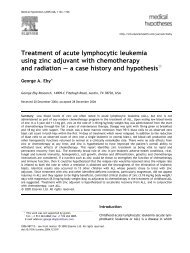Therapeutic Gallium Compounds - George Eby Research Institute
Therapeutic Gallium Compounds - George Eby Research Institute
Therapeutic Gallium Compounds - George Eby Research Institute
You also want an ePaper? Increase the reach of your titles
YUMPU automatically turns print PDFs into web optimized ePapers that Google loves.
260 <strong>Therapeutic</strong> <strong>Gallium</strong> <strong>Compounds</strong><br />
gallium was poorly absorbed from oral ingestion of common gallium salts or<br />
chelates, 4 and that injected gallium (generally as the citrate) tended to concentrate<br />
in bone, liver and kidney tissue. 5 Attention quickly turned to gallium radioisotopes,<br />
particularly 72 Ga, as these could be easily used to trace the distribution of<br />
gallium in experimental animals and humans. 6 Radiogallium was soon found to<br />
concentrate in regions of high bone turnover, particularly in some bone tumors. 7<br />
Based on these findings, a preclinical and clinical study (34 patients) was<br />
undertaken to explore the use of radioactive 72 Ga to treat primary and metastatic<br />
bone cancers. 8 The guiding hypothesis was that 72 Ga would become<br />
highly concentrated in tumors, which would then be destroyed by the localized<br />
radiation. Results indicated that due to its short half-life (14.1 h), by the time<br />
the 72 Ga became concentrated in the target tumors, the radiation level had<br />
already decreased so much as to be ineffective, while the patient had been<br />
subjected to undesirable levels of whole body radiation. 8 In addition, since<br />
72 Ga was produced by neutron irradiation of stable 71 Ga, from which it could<br />
not be chemically separated, 72 Ga was by necessity administered with large<br />
amounts of non-radioactive ‘carrier’ gallium, which was felt to pose a toxicity<br />
risk. The use of non-radioactive gallium as a therapeutic agent was apparently<br />
not contemplated at this time, and no further work on the potential therapeutic<br />
use of gallium appeared until the 1970s. The studies of the early 1950s did,<br />
nevertheless, produce data on gallium tissue distribution in experimental animals<br />
and humans, and ultimately led to the now widespread use of radioactive<br />
gallium (mainly 67 Ga, with a half-life of about 78 h) as a diagnostic agent for<br />
some cancers, infections and inflammatory diseases.<br />
<strong>Research</strong> conducted from the early 1970s to the present has demonstrated<br />
that non-radioactive gallium has several therapeutic activities, including<br />
(a) decreasing accelerated bone mineral resorption and lowering associated<br />
elevated plasma calcium levels; (b) inhibiting neoplastic proliferation; and<br />
(c) treating certain infectious diseases, particularly those caused by intracellular<br />
organisms. In animal models, gallium also has shown selective immunomodulating<br />
activity, particularly relating to allograft rejection and autoimmune<br />
diseases. Recent reviews 9–11 have covered much of this research and have<br />
discussed in detail what is known of gallium’s mechanisms of action. Although<br />
we are a bit ahead of Mendeleev when he described gallium before it had been<br />
observed, we still have only taken a glimpse into gallium’s therapeutic potential.<br />
14.2 Chemistry and Mechanisms of Action<br />
14.2.1 Aqueous biochemistry<br />
The chemistry of gallium as it pertains to physiologic solutions has been<br />
reviewed, 9,12–14 and will be only briefly summarized here.


